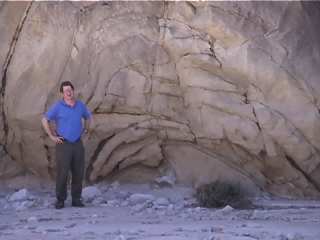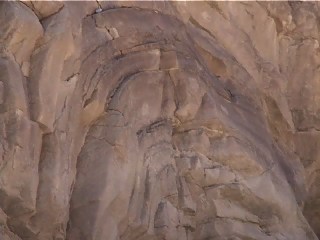 | 

The Evidence from Geology
Sediment Formation
An examination of sedimentary rocks and of the fossils found in sedimentary rocks provides evidence that they were laid down quickly and catastrophically, not slowly and gradually. First, the occurrence of soft invertebrate animals being fossilized must have occurred by rapid burial, or the animal would have decayed quickly. For example, soft bodied invertebrates like crinoids can be found en masse as fossils. Another indication of rapid burial is seen in bivalve mollusks (clams). When a clam dies naturally, the two halves of the shell open up and break apart. Many, many fossil clams are found with their shells closed, indicating that they were buried alive or immediately after death, so the rock layer containing the fossil must have been laid down quickly, not slowly and gradually. A second example of rapid burial in catastrophic conditions is found in Nautiloid Canyon, a side-canyon of the Grand Canyon. In this canyon there are scores of straight-shelled nautiloids fossilized. An interesting thing about them is that they are oriented in one primary direction—indicating that they were buried while in a strong current (Austin, 1994). A third indication of catastrophe in geology (or that sedimentary layers were laid down rapidly) is the common occurrence of "polystrate" fossils. Polystrate fossils are vertically-oriented fossils that span several rock layers. Common examples are trees standing upright in coal mines, or vertebrate bodies, or other plant material. These fossils could not have been partially exposed for even centuries without decaying. They, along with the rock layers in which they are embedded, seem to have been deposited very quickly. A fourth indication that sedimentary rocks were deposited catastrophically is seen in the grains of rock. For example, the cross-bedding orientation of the Coconino sandstone is very similar to the sand wave deposits that are generated by large storms or amplified tides (Austin, 1994). These are a few of many indicators that sedimentary rocks were deposited quickly under catastrophic conditions. These examples fit the predictions of both the young-earth creation model and of the neo-catastrophism old-earth model, but are not explained well by the uniformitarian old-earth model. There is further evidence, however, that seems to indicate that sedimentary rock layers were deposited in very fast succession, without millions of years in between (as the neo-catastrophe model predicts). Soft-sediment deformation
Soft sediment deformation means that sedimentary rock layers were bent or broken while still soft. The old-earth interpretation of rock layer deposition is that the layers were formed over millions of years, and then a tectonic event would deform all the layers of strata that were deposited. This would result in deformation of hard rock. The young-earth interpretation is that "great thicknesses of sedimentation were laid down during the year of the flood.... Much deformation would have taken place late in the flood as the oceans were deepened and widened and the continents were uplifted" (Morris, 1994). Under these conditions, the rock layers would have still been soft, and we should see locations where the rock has been bent.  | Examples |  | Split Mountain: 
|  |  | 
Split Mountain is a site in southern California where 17,000 feet of strata have been twisted into tight folds. (See pictures above and below.) These strata represent layers of Miocene to Pleistocene rock and evolutionists have interpreted them as being formed over a period of 6 million years after which they were deformed. The intense, tight folding of the rocks, however, indicate that they underwent deformation while they were non-lithified, or in a soft, plastic state. (Austin and Morris, 1986).
 |  | 

Front Range, Colorado: |  |  | A second example of deformation occurring in soft sediment is in an area on the Ute Pass Fault in Colorado. This area is composed of 14,000 feet of rock dating from Cambrian to Cretaceous, and is characterized by clastic dikes, tight drag folds, and intense monoclines. Evolutionists have claimed that there were 430 million years between the deposition of these layers and the deformation event. An examination of the folded layers, however, indicates that the Cambrian layer was in a non-lithified condition when that part of the Rocky Mountains was uplifted! (Austin and Morris, 1986).
 |  | Clastic Dikes: |  |  | A third example of soft sediment deformation is clastic dikes. Clastic dikes are vertical, wall-like features made up of previously-existing rock, buried underground (Morris, 1994). The young-earth interpretation of the formation of clastic dikes is that the source-bed rock (bottom layer) was not hardened when the top sedimentary layer covered it, so material from the lower layer oozed through cracks in the upper layer and hardened in dike shaped formations. The old-earth interpretation of their formation is that the bottom layer was hardened, but still squeezed up through cracks in overlying limestone! The evidence supports a non-hardened source-bed which was squeezed like paste through cracks in the upper layer (Morris, 1994)
 |
Summary
Models that relate to the age of the earth have different predictions about what will be found in geology to support them. The young-earth model centers on a literal interpretation of the global Flood of Noah's time as recorded in Genesis 7 and 8. The model states that most of the sedimentary rock layers we see were deposited during the Flood, or soon after as a result of drainage from the receding waters. The model predicts that we should find evidence of rapid deposition, burial, and erosion and of hydraulic catastrophe. The old-earth models say that either the sedimentary layers were deposited and eroded slowly and gradually (uniformitarianism) or were deposited by many catastrophes that were separated by millions of years (neo-catastrophism). The uniformitarian model predicts that there is evidence of slow, gradual deposition and erosion. "The present is the key to the past." Neo-catastrophism predicts that there is evidence of intermittent catastrophes separated by long ages. The rapid burial and fossilization of soft-bodied animals, the orientation of the nautiloids in Nautiloid Canyon, the presence of polystrate fossils, and the character of sandstone cross-bedding all reflect catastrophe(s). These support both the neo-catastrophism model and the young-earth model. However, examples of soft-sediment deformation (as those seen at Split Mountain, Rocky Mountains, and in clastic dikes) seem to point explicitly to many layers of sediment deposited over each other in rapid succession so that the lower layers were still unlithified when the upper layers were deposited. A tectonic event would therefore deform all the unlithified layers together. This supports the young-earth model better than it supports the long ages of the neo-catastrophism model.
 
References
Austin, Steven A. 1994. Grand Canyon: Monument to Catastrophe. Institute for Creation Research Santee, CA. p.24-26; 32-34. Austin, Steven A. and Morris, John D. 1986. "Tight Folds and Clastic Dikes as evidence for rapid deposition and deformation of two very thick stratigraphic sequences." Proceedings of the First International Conference of Creation vol. II. Creation Science Fellowship. Pittsburgh, PA. p.3-13. Morris, John D. 1994. The Young Earth. Master Books. Green Forest, AR. p.106.


|

